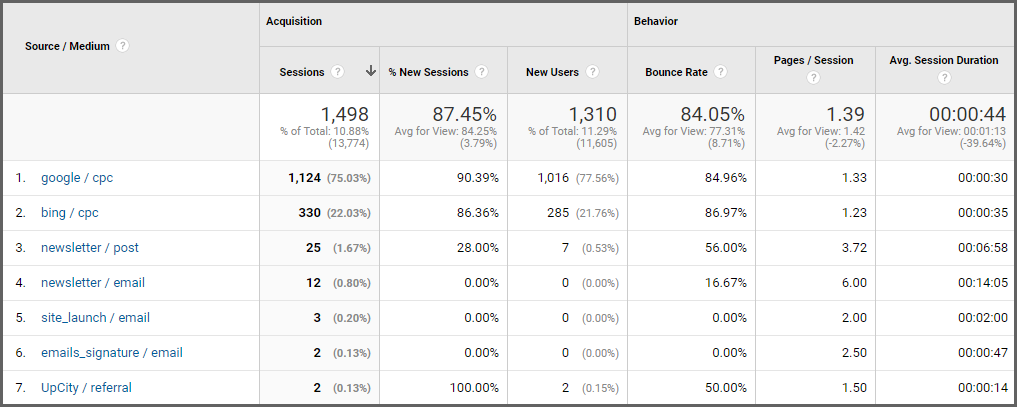Posted on 6/23/2020 in Digital Marketing
Have you heard of UTM parameters? Do you know what they are and why you should use them in your digital marketing campaigns? Plainly stated, they are unique tags that you add to a URL. These tags are sent back through your Google Analytics for tracking purposes. If you are attracting and driving visitors to your website, appending your URLs with UTM parameters can help capture and monitor the performance of your campaigns. This valuable information will help with optimizing your campaign traffic sources and future marketing efforts. They will also provide you with extremely valuable insights into your traffic.
Other important reasons to use UTM parameters is they help identify top-performing channels and the links that are driving the most traffic and conversions. Understanding this data will help you to measure your marketing campaign effectiveness and design future campaigns to be more focused on your business’s goals.
Urchin Tracking Module (UTM) parameters are five variants of URL parameters used by marketers to track the effectiveness of online marketing campaigns across traffic sources and publishing media. When using these UTM variants, be consistent with your naming conventions. For example, always use lower case letters and terms your team will understand so they will be identifiable down the road for reporting purposes.
The five UTM variants are as follows:
- utm_source: Typically the advertiser, site, social media platform, publication, etc. that is sending traffic to your property, for example: google, twitter, facebook.
- utm_medium: The advertising or marketing medium, for example: cpc, remarketing, banner, email newsletter, post.
- utm_campaign: The individual campaign name, slogan, promo code, etc. for your product or offering.
- utm_term: Identify paid search keywords. If you're manually tagging paid keyword campaigns, you should also use utm_term to specify the keyword.
- utm_content: Used to differentiate similar content, or links within the same ad. For example, if you have two call-to-action links within the same email message, you can use utm_content and set different values for each so you can tell which version is more effective.
Here is an example of how you should utilize UTM parameters in your marketing campaign URL:
We will be promoting our latest blog by running Cost-Per-Click (CPC) Google ads and using this URL-
Here is the breakdown of the variants we will be using-
- utm_source: google
- utm_medium: cpc
- utm_campaign: blogpromo
This is the final URL for this campaign, which includes the UTM parameters of:
https://www.wakefly.com/blog/the-top-4-benefits-of-bidding-on-your-branded-terms/?utm_source=google&utm_medium=cpc&utm_campaign=blogpromo
We chose to null values for utm_term and utm_content as the first 3 variants used will provide us enough information to analyze and monitor campaign performance.
Google provides us with a neat Campaign URL Builder tool that lets you easily append your marketing campaign URL. Check it out!
If you are using UTM Parameters in your URLs for future marketing campaigns, this information will be parsed out in analytics reporting. In Google Analytics for example, if you are running active Google Paid Ads pushing visitors to your website using a URL with appended UTM parameters, this is an example of the reporting located in your Google Analytics Property (Acquisition > Campaigns > All Campaigns > Dimension - Source/Medium):

As you are thinking about your next marketing campaign promoting your website, blog, newsletter, etc. keep UTM parameters in mind and add the Campaign URL Builder to your marketing toolbelt. Bookmark it! You will be glad you did, as it will make attribution a breeze.
Wakefly has recently made the Top Digital Marketing Agencies According to Marketing Platform. It would be our pleasure to partner with you!
Sources:
Wikipedia- https://en.wikipedia.org/wiki/UTM_parameters
Google Analytics Help- https://support.google.com/analytics/answer/1033863?hl=en)
Campaign URL Builder- https://ga-dev-tools.appspot.com/campaign-url-builder/
Struggling to get more visitors to your site?
Request a Free SEO Audit of Your Website!Related Articles

How Do I Optimize My Website for AI?
Why do you need to optimize your website for AI?AI-powered search engines like Google’s AI Overview, Perplexity, and tools such as Microsoft's [...]

Outdated or Outstanding? How to Tell If Your Website Needs a Refresh
Your website is the digital face of your business. It serves as a first impression, a marketing tool, and a resource for potential customers. [...]

Preparing a Website Redesign Budget for 2025: A Step-by-Step Guide
As we approach 2025, businesses are recognizing the necessity of a fresh, user-friendly website to stay competitive in a rapidly evolving digital [...]
